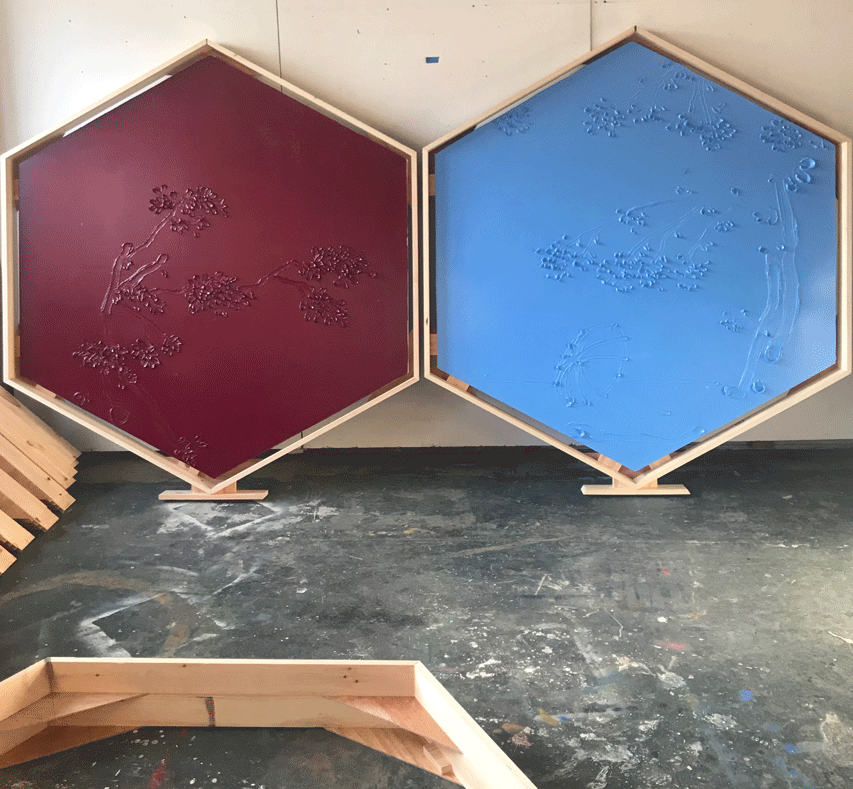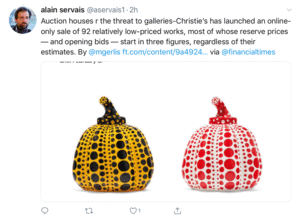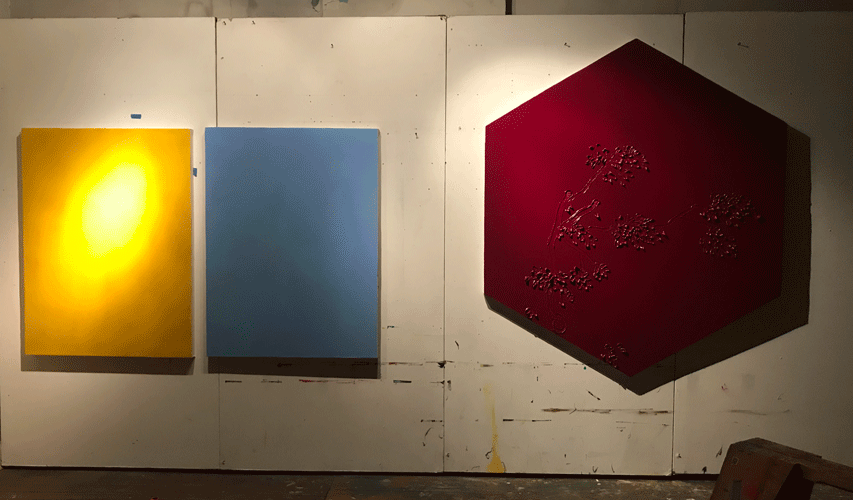January 30, 2020
January 29, 2020
Where is the love? Part Two.
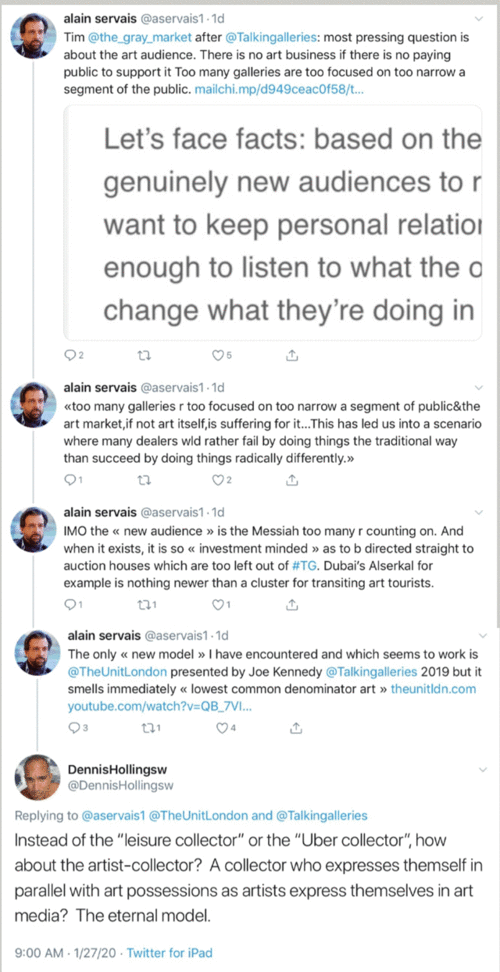
(Reference: The Gray Market: Why Art Dealers Need to Focus on New Audiences or Risk Irrelevance (and Other Insights)
Consider the sobering fact that while there has always existed more artists producing art objects in the world than there are enough collectors who will collect those art objects, today the population of artists in the world has increased in logarithmic scale, exacerbating this problem. In less technical terms, compared to the NYC art world of the 40's ands 50's when you could meet nearly all of the principal actors of that time in one night of openings and after parties, today this population has grown into gargantuan proportions. In the most vulgar terms that I have read/heard elsewhere, there's more inventory than consumers that the market can bear. What repulses me about this kind of business argot is that it is usually blind to the strangely delightful ironic twist at the heart in the consideration of art as a marketplace.
What you are reading above in the tweet thread is my reply that suggests an alternative conception of the collector in opposition to the characterizations, "leisure collector" and "Uber collector", instead I propose the collector in the model of the artist. In the tweet, I coined this on the fly perhaps in a clumsy way. Alternative nominations could be collector/artist or collector-as-artist or creative collecting. I hope you understand the thrust of this idea. It's a conception of the collector as I suggest as they always have been, thinking of the Gertrude Stein or Peggy Guggenheim or Count Panza or Herb and Dorothy Vogel.
Over the past twenty years, as the population of artists grew, there has been a strange erosion of the bottom and middle art market, leaving the top end chasing a narrowing sector of elite art works. Theories abounds as to the etiology of this condition whether it was because of the growth of art fairs or auction houses or both. No one yet really knows. In this meantime, certain speculators have entered the scene who see opportunity in 1) the unregulated Wild West of the art world, 2) the opportunity of creating mutually reinforcing artificial value structures and 3) the potential of an exploding inventory of art of ambiguously good/great value languishing yet unexploited. As an example of this, check this out: KIRAC 8 'The Art of Stefan Simchowitz' (Portrait of a Los Angeles Art Dealer). The effect of all this is to drive the urge to speculate in art, to treat art as a fungible form of currency. The effect of all this is to evaporate the population of people who collect as artists make art... with love, with passionate, existential love.
Below, watch the video that Alain Servais suggested, Joe Kennedy's Unit London, presenting his idea of an art gallery that urges a shift modeled on social media. Twenty minutes in, he coins the term "Leisure Collector". ""The role of the gallery is moving into this narrative of this, sort of like an agency sort of role where marketing and storytelling becomes central." From another direction yet in the same theme, I have a dear friend, an LA gallerist, who visits NYC frequently and we enjoy time together seeing art in the city. He has been pounding me with an idea of how artists should respond to our changing world which involves artists focusing not on producing masterworks seeking a home in elite collections but rather shifting attention to elite corporations who are focusing attention to the broader public such as Google or Hollywood or even MIT. What both people like Joe Kennedy and my dear friend have in common is an anxiety and frustration with the apparent disappearance of the classical collector, the category I'm trying to encourage here as the reintegration or revival of the passionate, creative collector-as-artist. Is this a romantic notion? No doubt. But what is an artist who isn't preoccupied with creating superlative art, seeking to overcome the frontiers of their imagination and make that physical?
Check out the question from the audience at T= 29:50, identifying the core problem of the artist in the consumer centered world. "...at the end, the artists are going to do what people like..." If you think that this isn't a problem, check out this video by Anna's Analysis, The Reality of Van Life on Social Media. "We've all heard that social media isn't real life, and everyone knows that van life isn't as glamorous as it is made out to be in Instagram..." Think about the possible parallels to the art world as you watch it.
UPDATE:
1. Gagosian is creating online viewing platforms.POSTSCRIPT:
2. Servais kindly alerts us about Christies upcoming online sales platform. He suggests that this move from the auction houses will threaten the market at the gallery primary market level. Would the purchase of a low four figure art Kusama supplant the purchase of an emerging artist or a lesser known/appreciated yet talented artist at a small or midsized gallery? Are the art markets, zero sum? An interesting question...
Another thought along these lines: Consider the axiom that art is valued in terms of prestige. Alongside that, another axiom that while pricelessness is subjective and personal yet ultimately fictional, it is instrumental in establishing the structure of pricing in the art marketplace. The less willing one is to part with the possession of something (a feeling either perceived or real, interestingly), the more value it can have in a market. Does it follow inevitably from these axioms, that artists will always be subjected to the lure of upmarket galleries who have marshaled a community of higher prestige? A kind of capillary action? Does this impulsive matriculation of artists contribute to "the rich getting richer" in our art world? Elsewhere, I have suggested the organic health food world as a context to compare and model from: slow versus fast food, shorter supply chains, "natural" versus synthetic ingredients, free range versus caged..."You are what you eat" becomes "You're only as authentic as what you collect". Of course, not to veer onto another topic, but to move in the directions that I'm suggesting in this blogpost, the art world would have to rethink accepted Pomo dogma that authenticity is dead and defunct, that it is a good and desirable quality again. Until that time, the erosion could continue unabated, unchecked.
Good luck with that.
Rereading Tim Schneider's headline:
The Gray Market: Why Art Dealers Need to Focus on New Audiences or Risk Irrelevance (and Other Insights)I would rather prefer this conceptual shift:
The nurture and growth (in gardening terms) of collectors (and the audience as the seed bed for future collectors, proto-collectors) who use their collections as a mode of expression in parallel with artists who use media as their mode of expression.
Clumsy, yes. But the payload is there and hopefully on target.
January 22, 2020
all war is deception
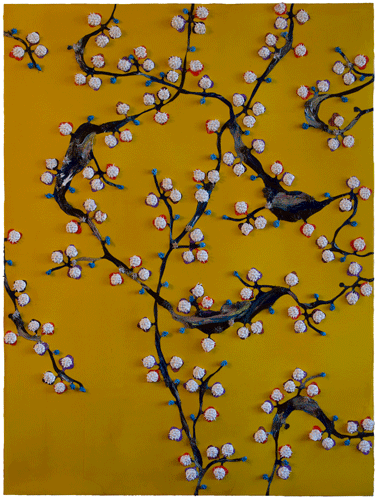
all war is deception
2020
#590
48" x 36"
Oil on Canvas over Wood Panel
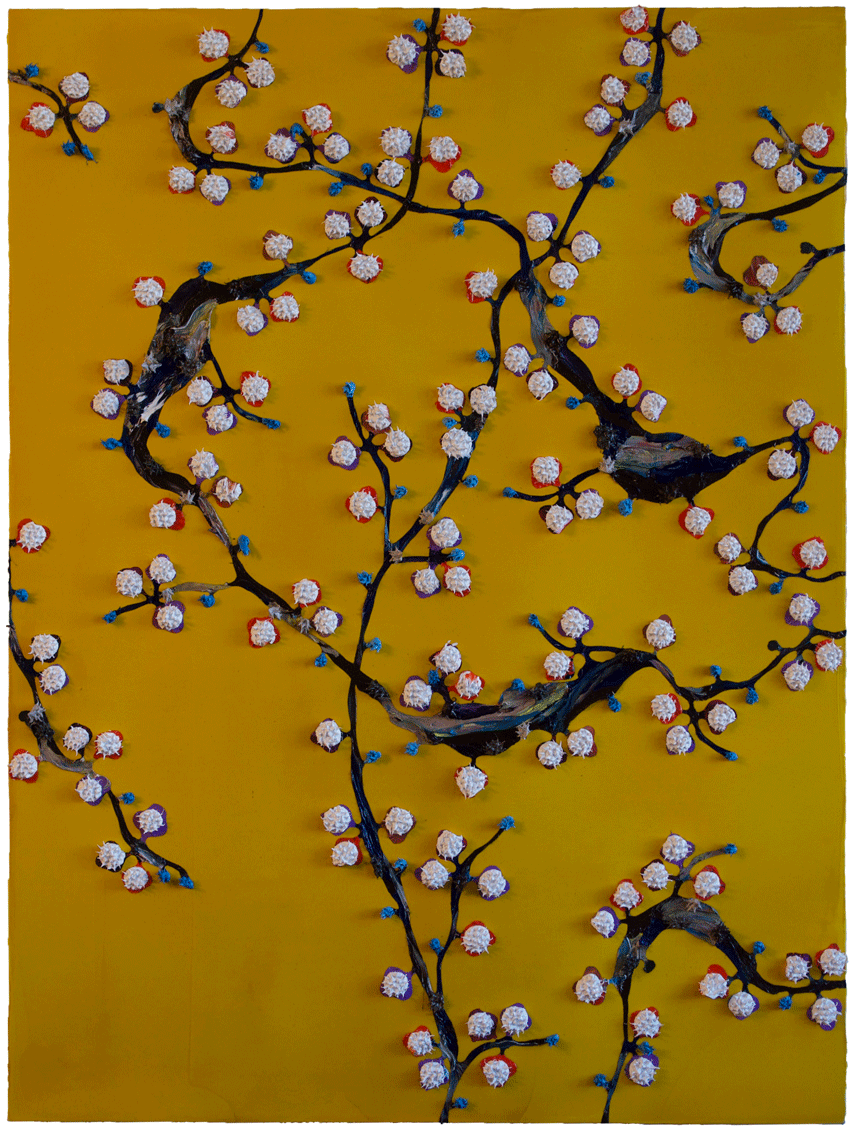
January 19, 2020
The Hexagon
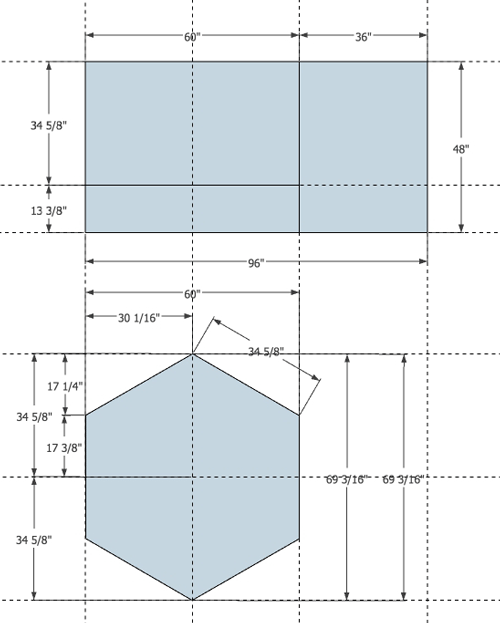
Art making is a reconciliation of three processes of intellection: intuition, an analysis of history plus its projection into the future, and the impact of personal narrative. Freedom is the basis of art. Art history is the generational critique of inherited culture and its revamping appropriate to the perspective of each milieu. Art is the media based exercise of freedom. Personal narrative is psychological understanding of the circumstances of ones existence. Intuition is an expression of deeper understanding below direct conscious thought. Intuition is best informed by a feral omnivorous curiosity, it arises inexplicably and involuntarily against a socially constraining framework.
I cannot account here fully the wellsprings of exactly how hexagonal shapes became compelling for me at this moment. The purpose of this blogpost is to chart as best I can at this moment the position and movement of this work.
The Prado paintings came to mind almost in a flash. Within the time frame of more or less a day, three thoughts arose nearly all at once, all in the context of what to paint next. First thought: a field of the same color paint would let me emphasize the formal qualities that I have featured front and center nearly my whole life as a painter. It would be a kind of painting that's more than drawing, but not by much. But what to paint? That's when the second thought arose: It's been 50 years since I first visited the Prado. The well of subjects there is bottomless. Scarring a monochrome surface with commemorating images, not a bad inside jibe to the purist mentalities still among us. I like to poke the rib of the conceit that abstraction could be brought to its eschaton in the final act of monochrome painting. Then there was an issue of continuity. I had been using a frisket mask one way or another for several years, going cold turkey didn't seem right. Then the third thought: an edge condition that could feel like the classical architectural ornamentation of the Prado, a distant echo. Regular undulations at the edge would frame the paintings, an edged fringe is a stage exit of the frisket mask.
It was a great run, but it couldn't last forever, commemoration is a time based activity after all. The Prado paintings are destined to be a limited set. As the year was coming to a close, a similar intuitive flash sequence happened. The edge condition dial on painting's instrument panel should be dialed down to the click of zero. The shape of the mask could shift to the shape of the canvas. OF all the planar shapes, a hexagon is closest to a square and rectangle, but only two ordinates away from the quadrilateral referents of conventional architecture, the ultimate destination of painting. I like that this geometry for painting implied a different geometry of an architectural housing. With this formal device, a drawing/painting on the monochromatic field would be kept in motion by the edges, contrary to the traditional rectilinear monochrome.

One last note in this hexagonal rumination, a salute to delightful genius. Vi Hart is a YouTube creator that balances science and imagination in a unique way. Her last upload is almost a year ago, apparently topping off a wonderful ten year run online. Wonderful, wonderful stuff.
A flood after years of famine
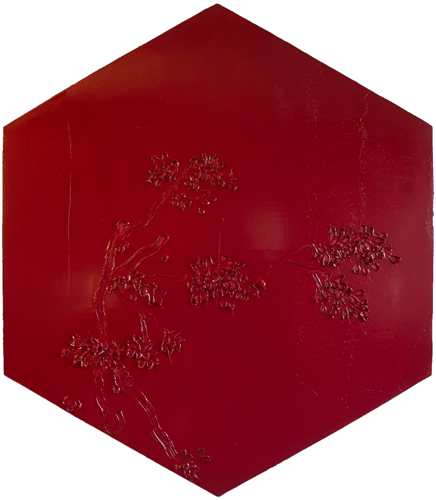
A flood after years of famine
2020
w/w #589
69" x 60"
Oil on Canvas over Wood Panel
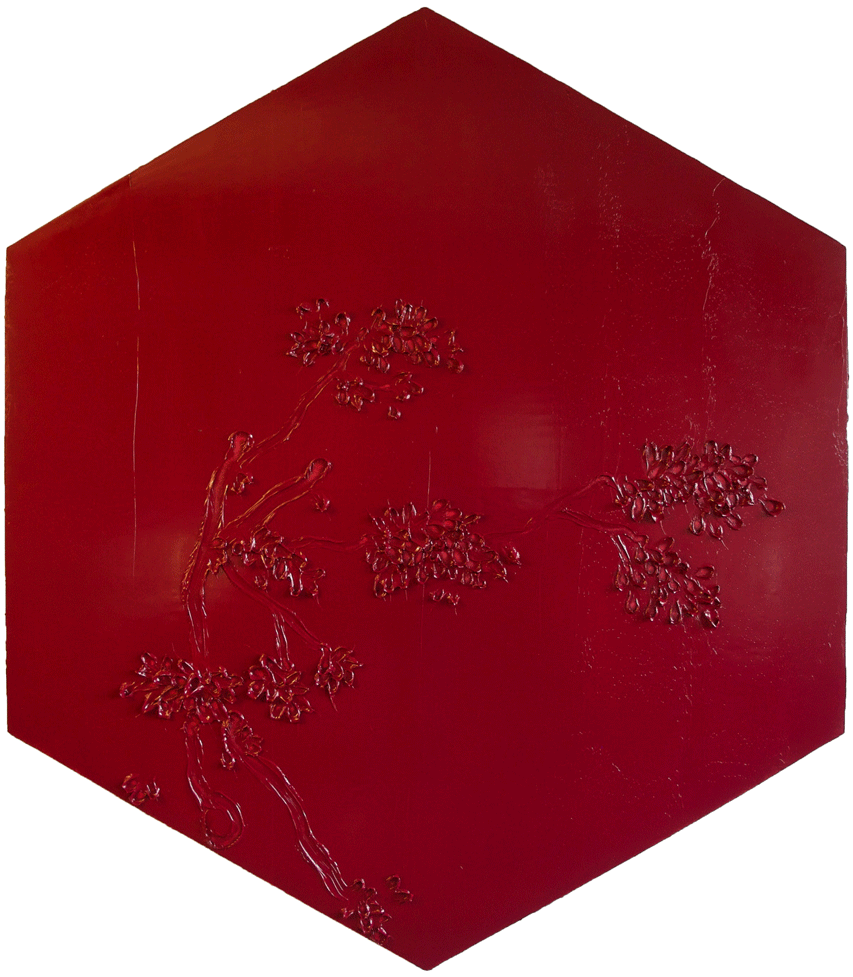
January 9, 2020
"IS THAT WHAT YOU'RE THINKING?"
There's a little story that I've wanted to recount to you guys here in the weblog. I've been drafting it in my head several times over in the past few days. I'll jump to the quick to salve any impatience: basically, this is about a teachable moment. In the meantime, I need to dress the scene adequately enough for those in this audience who are not well acquainted with the sport of fencing.
I'm not good at sports, never have been. A quick shout out to the legendary Chicago podcast Bad at Sports, very well named. Growing up with a father who never exhibited an interest in sports, moving around as much as my family did and being preoccupied with drawing and making things instead of team sports (we moved around a great deal as a military family) and involvement with objects that were spherical or related shapes... well, all this and probably more disposed me away from any popular sport growing up.
By the time I joined the Navy, turning 18 in bootcamp, I started to build in all those modules that I thought a guy should have. My dad was the strong and silent type. Of course I loved and respected him but he wasn't the kind of father who did a lot of shaping of his offspring. "You're on your own kid" was something he would say from time to time, the first time when I needed help with math homework. His deepest desire was that I would follow him into his passion for nature, travel and camping... but I would prove to be a disappointment on this front. So, by the time was in my early teens, being on my own, having the responsibility to shape myself physically and mentally, I was on my own. That was alright, it was all I had ever known.
After a few false starts (tennis, racquetball), I focused in on the sport of fencing. I'm not sure where the impulse came from. The influence was probably from an Uncle who lived a vivid life as a student in the University of the Philippines that I had witnessed in awe as a boy. His bedroom in my grandfather's home was a veritable museum filled with artifacts collected from his adventures in the Philippine Islands, swords among them. Aboard the cruiser I was stationed, I learned that there were a few shipmates who fenced, mostly officers who had fenced in college. So when we made a port of call in Singapore in 1975, I bought my first set of fencing gear. It was two sets actually, mask, foil and vest. We would practice together on the helicopter flight deck and hangar of the ship. When the seas were rough, the pitch and roll was interesting.
Actual effective lesson based training happened in my university years. There is one fundamental idea that governs fencing: that at its' origin, it was a dueling weapon drenched in the stakes of life or death combat. Accordingly, when a weapon was presented with an extended arm, it is a threat that must be dealt with prior to any subsequent action. Otherwise, suicide either singly or mutually would result. Sword fighting as a sport wouldn't make any sense outside of this parameter. So it is indispensable that an extended blade must be parried before a counterattack.
The control of distance is essential to the sport. Advancing and retreating in mirror form, you always want to be an inch away from your opponent's reach. The lunge closed distance explosively. Correct posture kept one ready to lunge at any moment. Posture and stance holds you ready for a lunge at any time. Feet at 45 degrees to each other, heels below your shoulders, knees bent. You must advance heel to toe, retreat toe to heel. To lunge, your foil and arm flies toward a target on your opponent. Then imagine simultaneously kicking a dime forward off your front heel, while simultaneously straightening your back leg. Do this in a controlled explosion, flying, and your momentum will carry you a little bit farther than a simple extension, overcoming your opponent's control of distance and drive the point home.
Fencing is one of the martial arts. Comparisons to chess and boxing are not trivial. It's not unusual to walk away from a bout with bruises from the impact of the blade. Action and counteractions compound factorially at speeds at the threshold of perception. The target area of foil fencing is the torso, which is divided into quadrants. Only one quadrant can be defended at a time. There is a recombinatorial economy of limits in that an attack into one quadrant exposes all other quadrants to a riposte. When an opponent attacks, all their target areas are wide open. In the immortal words of Sun Tzu, all warfare is deception, therefore the feint is fundamental. This is when you let it be known that you will attack into one zone but you switch off to another in the blink of an eye. It's all about establishing patterns and breaking them. You're telling a story and as soon as it is taken for granted, you pull the rug out from underneath them... like a really good story. Like a really good fight. Fencing is mind versus mind and the foil determines who wins and who loses.
Fencers are covered in protective clothing nearly from head to foot. Since the action is vigorous, a bout leaves you dripping in sweat. From the perspective inside the visor's metal mesh, peripheral vision is nearly irrelevant. Advancing and retreating to control distance, lunging to close distance, one's eye is fixed on the tip of the opponent's blade and body language is the key to knowing where next their blade will go.
In Los Angeles in the late 80's and early 90's, I fenced at the Westside Fencing Center in Culver City. It was a place that was a home for Olympic fencers, actors and enthusiasts like myself. People there ranged in age from little kids to seniors, people from all sorts of professions gathered there, it was interesting to get to know them all. I took note how the older guys conserved their energy even as they fenced vigorous youth, employing the wisdom of the years. Usually, a member of the club would contract with an instructor, engage in lessons and fence with others afterwards. It was kind of like going to a dance where one asked for a bout, closing social distance. There was a colorful spectrum of characters available as instructors, some classical, some jaunty, some quiet and brimming with the promise of a well of hidden knowledge, some more modern in their background and disposition. They wore gear that was distinctive and eccentric but usually black. Some moonlighted in Hollywood, others specialized in the world of the tournaments regional and international, some were European and it mattered if they were from Italy or Hungary. Each had a peculiar character stamp on how they taught the sport and if you switched up instructors it was best to bear that in mind.
So it was that one day after my lesson, I asked a guy for a bout. There was a subgroup of fencers who were too old for the Olympics but they carried on in casual tournaments. The kids were frenetic and sloppy and the older guys paced slow although a few of them still could best you in a bout despite that. Between these extents were the formidable middle who possessed the energy of youth but were assimilating the wisdom of how to control it. This guy was in his upper 30's, an accountant and you could see this in his bearing and how he handled his gear. Meticulous. Fit. He seemed to have extensive experience in college, his gear was worn, battle scuffed and well broken in.
We got on the piste, connected our gear to the wire score system and pulled on our helmets, testing the connection by pressing the button of the blade on the conductive metal lamé vests, colored lights flashing. I rather like the custom of the salute with foils at the beginning and handshakes at the end, so civilized. When you fence someone for the first time, you advance and retreat cautiously, studying your adversary, looking for a pattern to break, exhibiting a pattern your opponent thinks he could break.
I held my foil and comported my posture in the manner of my instructor and I laughed about it, commenting to the accountant that this is like so and so's style. I remember holding an image of the instructor in my mind, chuckling about him and his eccentricities.
The accountant stopped and furiously pulled off his helmet, piercing me with a slam of his eyes, disgusted. "IS THAT WHAT YOU'RE THINKING?" That accusatory moment cut me to the quick. It seemed to have lasted forever. I'll never forget this. What the actual fuck was I thinking, indeed? He caught me trivializing the art and sport of fencing. My head wasn't in the game. I was being meta. Cute. I thought I was being clever. I wasn't there to fence but to charm him. This was less than being a bad sport, I was using sport as an instrument for other ends, no matter how intentioned. The accountant pulled his helmet on and we assumed the posture en garde. We resumed the game and I never forgot his lesson.
Dave Chappelle quoted Miles Davis as he accepted his 2019 Mark Twain Prize, saying to his audience: "It took me all these years to learn how to play like myself." I remember one of the first things I was told in art school: "Anything that you have made and anything you had thought has been made and thought before. Nothing is new. The sooner you realize this, the better off you'd be." At the face of it, this is not a bad method as standard pedagogical practice. It's important to disabuse complacency, to kindle ambition and self knowledge. But if I were teaching art school, I would add that with much effort, it is possible if not desirable to exhaust the catalog of influence and arrive at a place all your own. Actually, this is indispensable for an art career of distinction.
It was the hall of mirrors epoch of Postmodernism that folded the realms of imitation and distinction into each other, deepening the complexity of existence. I believe that the erasure of distinctions is the soul of Postmodernism. Rauschenberg's DeKooning erasure is a signal act of the age. Every argument requires artifice, every story exaggerates, omitting some elements, inflating others, coloring outside of the lines. Picasso famously said that "art is the lie the reveals the truth". The Postmodern argument forgot this, taking itself too seriously. Truth is denied in a Postmodern worldview. If you doubt this assertion, explain the widespread acceptance of the assumptions glowing within Francis Fukuyama's "End of History and the Last Man". The effect of this is that we have assumed deep down that we have arrived at the eschaton, the end of the world and final events of the divine secular plan. We have, in our vanity, legislated the end of cultural succession, a coup e'état of future world views. This is a time where Narcissism and Autism are handy descriptors of people and experience. We are by and large, trapped within the helmet of Postmodernity, amused by inside jokes and ironic inversions. Nothing new is possible. There is nothing that needs be done. This is popular opinion in the art world today. Talking about this mental and social entrapment is disturbingly surprising within my community, if not odious to them when they are confronted with it. The subject of Postmodernism is verboten. The subject of History is verboten. Everything is everything, nothing is more important than anything else and few have any critique to present to this remarkably stubborn circumstance. The lane of acceptable discourse is avidly enforced, blinders firmly in place. This long-in-tooth Postmodern world is a Steady State Universe, relentlessly expanding until the last photon winks out. It is indeed old, 60 years old if you date its inception to the entry of Pop Art.
"IS THAT WHAT YOU'RE THINKING?"
To my fellow artists who might be reading this blogpost: what are you thinking when you are making art?
January 5, 2020
Prado Paintings

It was 1969, I was 13 years old. My family was en route to Australia. We had decided to immigrate to Sydney to join the majority of the relatives on my mother's side of the family who had immigrated there several years ago from the Philippines. My father was retired from the Air Force, living at that time near Eglin Air Force Base in the Florida pan handle. We took space available flights through Frankfurt to Madrid and lingered there for a week before we hopped on an embassy flight that hopped from Riyadh to Deli to Bangkok and a month long layover in Manila where we hung out with my grandparents in Malate.
Since I was born in Madrid, Spain always held a special allure for me. For years, I was already drawing and studying art in any way I could. It was mostly reading art history books and copying the illustrations. I had already known about the Prado and its treasures of Velásquez, Goya, Bosch, El Greco and Rubens. I had already read Irving Stone's "The Agony and the Ecstacy" a few months prior in Florida, a vivid memory. I remember asking my parents to buy a book on figure drawing at a bookstore in Frankfurt. That whole world was glowing, alluring for me. I spent most of that week in the Prado and I took a day trip to Toledo. I remember vividly the "Burial of Count Orgaz". There was an exhibition of Goya's Caprichos in the lower level of the museum. The week glittered.
It was this specific moment of my experience in the Prado, after the sequence of the galleries of those great artists... that I came upon Goya: his cartoons for the tapestries, his court paintings and then his Black Paintings. Then the truly seminal moment. I was standing in front of the famous "Saturn Devouring his Children" and Goya's world of paint telescoped into my eyes and mind. My entire visual field, my whole visual world was that painting and only that painting. Time, frozen. Everything and everyone around me disappeared and the only things that existed for that long, super-saturated moment were this painting and me. I don't know exactly how long that moment lasted. It could have been forever, or it could have been only a minute, it could have been both.
As the ordinary world returned to my senses, a resolution grew within me to become an artist, to become a painter, to return and remain in that realm so saturated with paint and churning with arts' urgent impulse. This is the subject of the ten paintings illustrated above.
A fifty year commemoration. Crazy, that so much time has slipped by already. The memories are as sharp in my mind as yesterday. I used an edge mask that undulated in a way that recalled the Classicism of the Prado's architecture. It was a bridge from the reliance from the masking of years of previous work to the facture of paint-as-drawing that I could do with my daubing tools like a finger dragging onto a monochrome bed. It was also a flippant commentary on the purity of the traditional purist monochrome, a friendly insult for the abstract absolutism of end-game modernism. And then I was able to exploit the hand-made letterpress-like cardboard stamps, each imprint a very special moment as the tools marked data onto the painting's surface.
A passing moment, there will never be another fifty year anniversary of this kind again... unless I commemorate my Navy days in 2024-29. An intriguing possibility...
January 1, 2020
2020
A new year and not so much as a resolution but a resolve to pick up the slack of this weblog that has plagued it over the past year. The culprit? The name of this pain would be social media. For a prolonged time, I had resisted getting involved in Instagram and Twitter. After much debate with a few friends, I capitulated and delved into the two social sites. This, to the apparent detriment of weblogging. The early years of this blog were more global in scope. At its inception in 2003, when my wife and I traveled to Spain for an extended time and weblogging was an effort to stay in touch with friends back in the states. There was much to report then, topics posted spread past the studio to accounts of life in the Costa Brava. I posted about art and anything adjacent. I learned HTML and played with formats. Everything notable/noticeable was a clue as to why art was made.
Fast forward to recent years and social media seems to have displaced some of the function of the weblog. The early success of "social influencers" and some artists who could transmit their studio product to collectors stirred my friends in the art community to jump on board. Enough time has passed to show that the promise of social media doesn't evenly distribute itself into the world at large. Social influencers favored young (wealthy) attractive women who could steer the markets of the fashion industry. Markets crystallized onto a few and stubbornly stuck in place. As for the promise of a democratizing promotional art marketplace, let me suggest that Instagram favors only the top tier artists who had already garnered an enthusiastic audience before they entered the fray, amplifying an already successful market for them. The rich, getting richer. Sound familiar? This assessment isn't absolute, and there has certainly been some effect for aspirants in either sector... but the gains I believe have been only modest for most of those outside of this elite.
My initial beef with Instagram remains in place after a couple of years of surrendering to its charms. Similar to Facebook (which I had exited from a while ago already), it was admittedly nice to be in the place all my friends were. I never had monitored at my weblog stats, but my initial plunge into social media illustrated the end of the early halcyon days of the web log and a social communication platform. My critique is that the successor media was a diminishment of expression. The one-size-fits-all cookie cutter format of Facebook narrowed further and drastically with Instagram. How mistaken I was when I thought years ago that artists would reject this and out-do each other publishing their own website/weblog platforms, blowing minds and enlarging spheres of expression. How strange to see meek compliance and arrested development in the world that was birthed with the Salon de Refusés and the shot of Alfred Jarry's pistol.
The larger effect has been a spreading delta spectrum of communication modes that we all must keep tabs on. Emails, Instagram messages, Twitter monitoring for breaking news and direct messages, text messaging on multiple platforms (the standard cell phone messaging, WhatsApp and now Signal), and others that grow on the horizon... our Information Age has unfolded into a broad spectrum that challenges our limited capacity to spread attention. Meanwhile, the silos get larger and fewer. When we haven't stopped exchanging information for fear of social ostracism, we get exiled from the social media for wrong-think. And all the while, social media cashes in, monetizing personal data to sell to desperate advertisers/manufacturers, all chasing consumers freed from the traditional big three networks and handful of "authoritative" newspapers and magazines (dinosaurs, all). An irony that seems to be lost on all is that social media flaunts "Liberal" consumerism criticality while they build empires monetizing everything in sight. Governments we can't trust (I'm looking at you, CIA) ally with data+money hoarding companies (I'm looking at you Amazon, Google and Facebook) and transparency isn't given a second thought by either any of these players or the victim/public/sheep at large. This is all so grotesque and pathetic.
Depth is becoming elusive.
A hall of mirrors. A world of surfaces. Lost in a forest of signs.
The best response it to resist it.
Fight.
Here. In this little corner at least. So, I'll double down and re-prioritize this weblog and give social media like Instagram a demotion in status in my little circle of the world.
*
*
*
UPDATE: A friend sent this in today: THE AGE OF INSTAGRAM FACE
